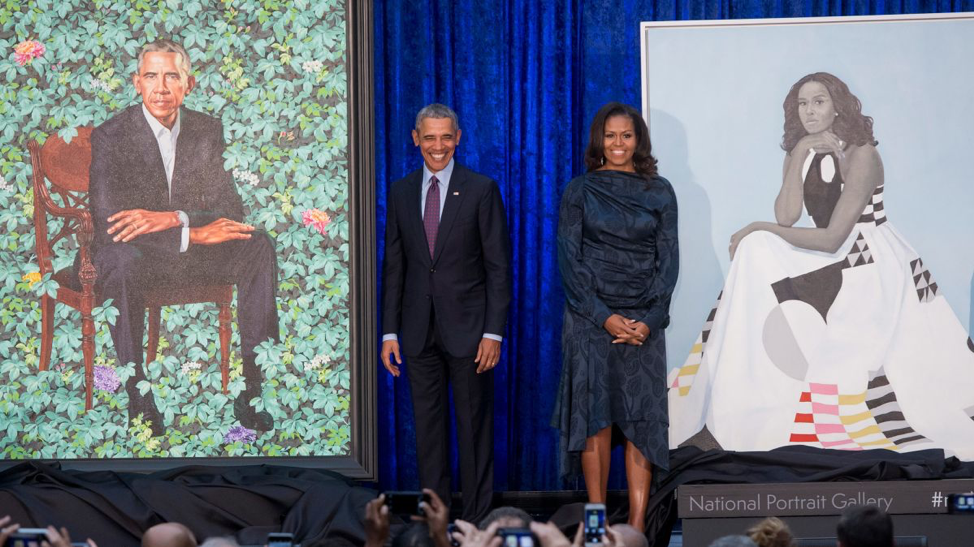John Singer Sargent famously said that a portrait is a painting with something wrong with the mouth. Two portraits have been much in the news lately, as the National Portrait Gallery announced that its portrait of Barak Obama by Kehinde Wiley and its portrait of Michelle Obama by Amy Sherald will be going on a coast-to-coast tour to five museums. Visitors coming specifically to see the portraits have doubled the National Portrait Gallery’s annual attendance since they were unveiled there in 2018.

Sargent’s comment is indicative of the power struggle, implicit or not, between the artist and the sitter as to how they really look and how they are to be depicted. President Obama alluded to such a struggle in his remarks at the unveiling. Wiley had become famous for his paintings depicting young African-American men in poses derived from Old Master paintings. His initial thought was to depict Obama in the trappings of royalty, or as the President said, to “elevate me and put me in these settings with partridges and scepters and thrones and shift robes and mounting me on horses. And I had to explain that I’ve got enough political problems without you making me look like Napoleon. We’ve gotta bring it down just a touch.” And the artist did.
The two portraits are now property of the nation, but there would be a hot market for them if they were able to be sold. A hot market is a rare exception for portraits in general. Unless the sitter is famous or infamous, George Washington or Jesse James, most collectors are not interested in displaying a portrait of someone else’s ancestor. If the sitter is an attractive young woman or a beautiful mother holding a darling child, there might be a buyer, but otherwise selling portraits is a tough slog for a dealer.
Two portraits I sold many years ago illustrate the matter perfectly. Each was a life-sized painting by William Merritt Chase of a person shown in three-quarter length against a dark background. The first painting was of a Philadelphia debutante, a beautiful young woman smiling in a white lace gown. I sold it for $225,000. The second painting was of a white-haired gentleman in a black coat and tie. He had been president of the bank, now defunct, which commissioned the portrait for its boardroom. I was lucky — a small museum which wanted a Chase painting but did not have the funds for one of Chase’s landscapes offered me $10,000 for this painting. I took the money and ran.
If you’re thinking of commissioning your own portrait, be aware that your children will keep it and then maybe your grandchildren, the generation that knew you personally. After that, if you don’t want your painting to molder in the back of some thrift shop, here are some rules to keep in mind:
- Be aware that your name is going to drop out. This painting is not going to be called “Portrait of Mary Smith,” it will be called by a generic title – “Lady on a Sofa,” “The Red Dress,” or something like that. You will become an anonymous model.
- Get something else going on in the picture besides you just sitting there. You can be watching a bowl of goldfish or pouring a glass of wine, anything to add a secondary subject to the painting. The portrait will eventually be called by the activity depicted, such as “Arranging the Tulips.”
- (This rule is basically for women, as men’s fashions don’t change with anything like the frequency of women’s fashions.) Wear clothing with classical lines, and don’t have a hairdo that is pegged to a specific short period of time. Think, for example, of the beehive hairdos of the Sixties and how funny they look to us now. Of course, it is always the fashions of thirty years ago that look embarrassing to the present day. If your portrait can survive for a hundred years, the fashions in it will simply become part of the historical record. We have no problem now with portraits of 18th century women in elaborate powdered wigs.
The rules above apply to portraits of individuals. If you want to commission a portrait of your family, forget any future market. Nobody wants to buy a portrait of someone else’s family. The artist in such a case knows that he or she is simply working for the pay and will expect the painting to be tossed out on some future curb. The exception to this rule, as he was in many things, was the late George Deem. Commissioned to paint a family portrait, he instead painted an interior scene worthy of Architectural Digest, depicting an elegant coffee table with flowers and books, a designer sofa, an end table with a fancy lamp, and so on. Hanging on the wall above their sofa was the portrait of the family. It was a brilliant idea. There will be a market for that painting when it leaves the possession of the sitters.

